AustLit
-
Many of the texts in the CLDR full text collection represent Aboriginal Australians from a colonist or imperial point of view. These representations typically rely on a number of stereotypes including depicting Aboriginal characters as childlike, comic relief or the fool, uncivilised savages or sly, cunning manipulators. Other texts exclude any reference to Aboriginal peoples and thus create a silence around the original inhabitants of Australia thereby reinforcing the notion of terra nullius.
This Trail endeavours to raise awareness of these representations and promote resistance to them. It is centred on a number of journal articles which interrogate these representations (Bradford) and/or provide alternative readings of the texts (Collins-Gearing). It also includes a number of the works of fiction discussed by Collins-Gearing and Bradford.
Trail created by Cherie Allan.
-
Australian children's literature has a history of excluding Indigenous child readers and positioning non-Indigenous readers as the subject. Rather than portray such literature, particularly that published before the 1950s, as simply racist or stereotypical, Collins-Gearing argues that it is important for teachers, of all students, to help readers understand how nationalist or white Australian myths were constructed on Indigenous land and knowledges. Two articles by Brooke Collins-Gearing are of particular importance to the CLDR archive, and are available in full text:
Re-Reading Representations of Indigenality in Australian Children's Literature : A History (2006)
Imagining Indigenality in Romance and Fantasy Fiction for Children (2003)
Brooke Collins-Gearing is a Murri woman who teaches at the University of Newcastle. Visit her record to learn more about her and her research.
Clare Bradford has also written extensively on representations of Aboriginal peoples in Australian children's literature. In Fading to Black : Aboriginal Children in Colonial Texts, she examines how the use of language, as well as particular characterisitcs of the illustrations, position child readers to develop, mostly negative, constructions of Aboriginality. She discusses how, on the other hand, the white child characters are represented as heroic. These representations lead to the creation of an us-and-them mentality, thereby reasserting binaries such as white/ black, civilised/savage and so on. In Representing Indigeneity : Aborigines and Australian Children's Literature Then and Now, Bradford discusses the representations of Indigeneity in Australian children's literature then and now. She examines three texts: A Mother's Offering to Her Children by A Lady Long Resident in New South Wales (1841), The Australia Book by Eve Pownall (1951), and Tjarany Roughtail by Gracie Greene, Joe Tramacchi, and Lucille Gill which was published by an Aboriginal publishing house in 1992. By analysing each of these texts in turn Bradford examines a number of changes that have occurred over time in the representations of Aboriginal people in a selection of children's literary texts.
-
 Title page of the first editionTakes the form of a dialogue in which the mother of the title, Mrs Saville, talks to her four children, Clara, Emma, Julius and Lucy as they sit together each evening. The children ask their mother questions which lead to narratives about shipwreck, station life and Australian flora and fauna, interspersed with moral lessons for the children. (...more)See full AustLit entry
Title page of the first editionTakes the form of a dialogue in which the mother of the title, Mrs Saville, talks to her four children, Clara, Emma, Julius and Lucy as they sit together each evening. The children ask their mother questions which lead to narratives about shipwreck, station life and Australian flora and fauna, interspersed with moral lessons for the children. (...more)See full AustLit entryThe ways in which the Aboriginal peoples and their cultures are represented serve to position the woman of the title (Mrs Saville) and her children as superior.
-
An adventure story in which two brothers, George and Alec Law, in order to save their family’s sheep station from an unscrupulous ‘friend’, set out on a search for a lost gold deposit supposedly beneath a waterfall at the far end of their property. They embark on their quest with the help of two young Aboriginal boys, Murri and Prince Tom. (...more)See full AustLit entry
While it is evident that the Law brothers would never have located the gold without the guidance of Murri and Prince Tom the text positions readers to see the white boys as the heroes of the tale and the Aboriginal characters as comic relief, child-like, and/or dishonest.
-
 On their final day at their boarding school, Stormont House, Susie, Nelly, and Trix pledge to remain friends. Though the three very different girls will go their separate ways, they agree to stage a reunion in five years and ensure that their friendship never fades. What will become of the girls of Stormont House when they leave school? (...more)See full AustLit entry
On their final day at their boarding school, Stormont House, Susie, Nelly, and Trix pledge to remain friends. Though the three very different girls will go their separate ways, they agree to stage a reunion in five years and ensure that their friendship never fades. What will become of the girls of Stormont House when they leave school? (...more)See full AustLit entryIn the course of this novel one of the girls comments: “Bush-fires and bush-rangers, and blacks. Squatters had lively times fifty years ago” (1900, p. 165).Collins-Gearing argues that this type of statement suggests that by the time spoken of, Aborigines had been subdued and were no longer dangerous or savage. This, in turn, stressed the nationalist image of Australia as cultivated and settled while implicitly revealing the fictitiousness of concepts and beliefs based on terra nullius. It promotes the belief that the indigenous presence had to be overcome before the white man could assert his own authority over the land.
-
 Recounts a visit from Sydney to Gooagalong Station on the Lachlan River by Dick Morrison and his friend Tom Flood. Dick's uncle owns the property and it is Dick's cousin Ned whom the boys have come to visit. The book details aspects of station life including riding horses, shooting kangaroos, encountering bushrangers and searching for gold. It also includes reference to Aboriginal life and customs which, invariably, are judged by the boys as inferior.See full AustLit entry
Recounts a visit from Sydney to Gooagalong Station on the Lachlan River by Dick Morrison and his friend Tom Flood. Dick's uncle owns the property and it is Dick's cousin Ned whom the boys have come to visit. The book details aspects of station life including riding horses, shooting kangaroos, encountering bushrangers and searching for gold. It also includes reference to Aboriginal life and customs which, invariably, are judged by the boys as inferior.See full AustLit entry
(...more)Despite detailed accounts of Aboriginal instruments and weapons, stemming from the author's obvious admiration for their technology, the Aboriginal characters are still represented as savages.
-
The owner of a far north Queensland property, Mr. Dennison, sets out on an expedition to New Guinea after his friend and neighbour (Mr. Maitland) agrees to move onto his property with his daughter Ruth , to look after Dennison’s farm and his two sons, Walter and Frank. After a number of years with no word from their father the two boys set out for New Guinea to discover what has become of him. (...more)See full AustLit entry
The early chapters detail a violent encounter between the Dennisons and local Aboriginal people. The local people are portrayed as savages and this is used to justify the white settlers' massacre of them. These chapters should be viewed in relation to the points raised by both Collins-Gearings and Bradford.
-
 A story of English settlers in Australia, bushrangers, felons, and escaped convicts. The novel follows the fortunes of George Caldecott who has come to Australia for an adventure. He meets up with an infamous local bushranger, Captain Stormalong, deals with several unsavoury characters, and solves a mystery surrounding the fate of a man to whom his mother was once engaged. He also meets and falls in love with a young woman, Lucy Walton. (...more)See full AustLit entry
A story of English settlers in Australia, bushrangers, felons, and escaped convicts. The novel follows the fortunes of George Caldecott who has come to Australia for an adventure. He meets up with an infamous local bushranger, Captain Stormalong, deals with several unsavoury characters, and solves a mystery surrounding the fate of a man to whom his mother was once engaged. He also meets and falls in love with a young woman, Lucy Walton. (...more)See full AustLit entryWhat is remarkable about this text is that in all his travels throughout the bush of both inland New South Wales and northern Victoria George Caldecott does not encounter any Aboriginal people. This illustrates the silence which surrounded the presence of the Aboriginal peoples of Australia in novels from early Australian children’s literature and reinforces the notion of terra nullius.
-
Visit BlackWords, which records a diverse range information about the lives and works of Aboriginal and Torres Strait Islander writers and storytellers and the literary cultures and traditions that formed and influenced them.
And Teaching with BlackWords for advice on best practice for Teaching with Indigenous stories.
You might be interested in...




